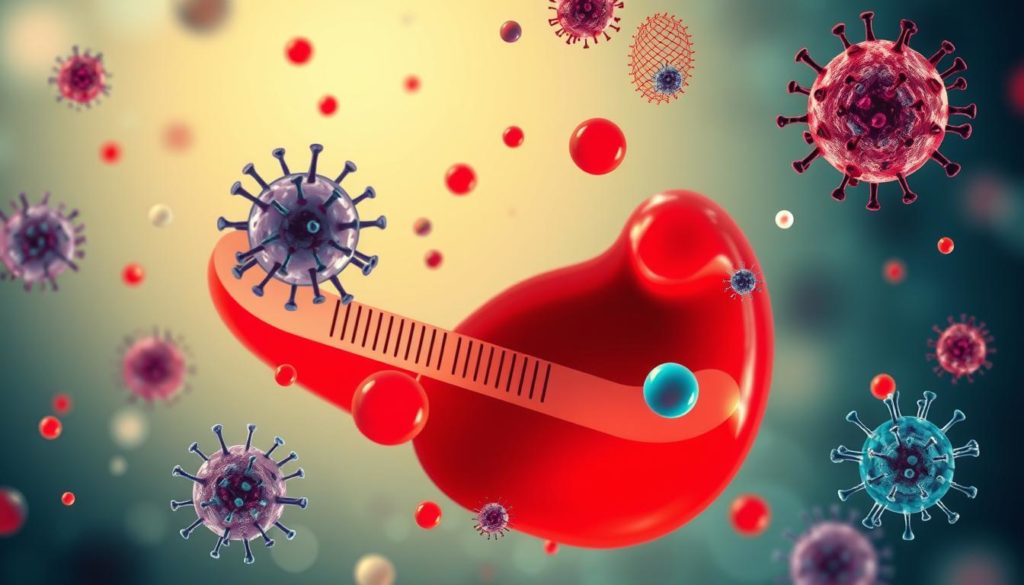Did you know that people with diabetes are more likely to get hospitalized from the flu? This is because they face extra challenges in managing colds and flu. These illnesses cause blood sugar levels to fluctuate and could lead to health problems.
Hormonal responses to infections might mess with how insulin works. This results in higher blood sugar levels. People with type 1 or type 2 diabetes need to be extra careful. That means keeping a close eye on their health and managing diabetes wisely.
Getting a cold or flu might make insulin less effective. This can spike blood sugar levels. For type 1 diabetes individuals, there’s a high risk of ketoacidosis. And for those with type 2, it might lead to severe issues like diabetic comas.
Knowing how infections affect blood sugar is key. Taking steps like washing hands and getting vaccinated helps. It’s important to monitor your health closely. Also, adjusting medication and staying hydrated is essential. Let’s dive deeper into how infections change blood sugar levels and why managing diabetes is crucial.
Understanding the Relationship Between Colds, Flu, and Diabetes
The link between colds, flu, and diabetes is complex. People with diabetes face more challenges when they get sick. Infections can deeply affect their blood sugar levels and how they manage their diabetes.

How Infections Impact Blood Sugar Levels
Infections like colds and flu cause stress hormones to release. This includes cortisol and adrenaline. These hormones fight the illness but raise glucose levels too. This makes managing diabetes harder, as blood sugar levels can spike.
Potential Risks and Complications
During an infection, diabetes complications can worsen. For example, people with type 1 diabetes can get ketoacidosis, where the blood turns too acidic. Those with type 2 diabetes, especially seniors, might see very high blood sugar levels. This could lead to a diabetic coma. It’s important to avoid infections and manage blood sugar well during sickness.
| Complication | Type of Diabetes | Description |
|---|---|---|
| Ketoacidosis | Type 1 | Severe accumulation of acids in the bloodstream |
| Diabetic Coma | Type 2 | Extremely high blood sugar levels, potential for loss of consciousness |
Good blood sugar control and taking steps to prevent sickness are key. By knowing how infections affect diabetes, people can protect their health better.
Common Symptoms and How They Differ
When we talk about flu and stomach flu, it’s key to know their differences. Flu has its own set of signs while stomach flu affects you differently. Knowing these can help tell one from the other. This helps in treating flu and managing diabetes symptoms better.
Distinguishing Between Influenza and the Stomach Flu
Influenza, or the flu, usually means you have a fever, cough, sore throat, body aches, and chills. These symptoms are tough on the body, especially for those with diabetes. On the other hand, the stomach flu causes nausea, vomiting, diarrhea, and stomach pains.

Key Symptoms to Monitor
It’s important to know what to watch for with these illnesses. This helps in getting the right diagnosis and treatment fast. For the flu, watch out for a high fever, bad cough, muscle pains, and feeling very tired.
- High fever
- Severe cough
- Muscle and body aches
- Fatigue and weakness
For the stomach flu, look for diarrhea, feeling sick and throwing up, belly pains, and sometimes a fever.
- Diarrhea
- Nausea and vomiting
- Stomach cramps
- Occasional fever
People with diabetes need to act fast when these symptoms appear. It stops their blood sugar from getting out of control. Knowing the difference between these illnesses means getting the right help. This prevents health problems from getting worse.
Preventative Measures for People with Diabetes
For those living with diabetes, taking steps to prevent illnesses is key. This includes keeping clean, getting the flu shot every year, and thinking about the pneumonia vaccine.
Importance of Hygiene Practices
Good hygiene habits are essential in avoiding diabetes complications. Cleaning and sanitizing surfaces often can cut down on germ spread. Also, washing hands well with soap and water is crucial. It’s a simple move that can greatly reduce infection risks.
Vaccination Recommendations
Getting vaccinated is vital in protecting against sickness for people with diabetes. It’s important to get a flu shot every year. This can help dodge serious flu issues and stays in the hospital. Doctors also suggest the pneumonia vaccine for extra safety and better health.
Proper Hand Washing Techniques
Washing hands the right way is very important for staying healthy, especially with diabetes. Make sure you wash your hands properly by following this guide:
- Wet hands with clean, running water (warm or cold), turn off the tap, and apply soap.
- Lather hands by rubbing them together with the soap, including the
Managing Diabetes During a Cold or Flu
When you have a cold or flu, managing diabetes can be tricky. You must monitor your blood glucose closely, adjust medications as needed, and stay hydrated. These steps help keep your blood sugar stable and prevent complications.
Proper Blood Sugar Monitoring
Illness can make your blood sugar levels go up and down. It’s very important to check your blood more often during this time. Try to test your levels every 2-4 hours. This helps you catch any changes early on.
Adjusting Your Diabetes Medication
Being sick can change how much insulin your body needs. Medication adjustments might be needed to keep your diabetes under control. Talk to your doctor about how to adjust your insulin or pills. They will tell you if you need more medicine while you’re sick.
Importance of Staying Hydrated
Staying hydrated is vital, especially with diabetes during sickness. Not drinking enough can make testing your blood sugar hard and make you feel worse. Drink lots of water and sugar-free drinks to keep your body hydrated. Skip drinks with a lot of sugar to avoid blood sugar spikes.
Recognizing When to Seek Medical Attention
Knowing when to seek medical attention is key for those with diabetes during a cold or flu. Don’t ignore symptoms, as complications can worsen quickly.
Signs of Severe Complications
Watch for symptoms that mean you need immediate emergency care. These include:
- Persistent high or low blood sugar levels
- Difficulty breathing
- Inability to retain fluids
- High fever
Guidelines for Adults vs Children
Both adults and children with diabetes must be carefully monitored. Special attention is needed for pediatric diabetes management:
- For children: look for unusual drowsiness or irritability.
- For adults: be mindful of prolonged weakness or chest pain.
Early recognition of these signs can stop severe diabetes complications. It also ensures timely medical attention.
Effective Treatments for Cold and Flu Symptoms
If you have diabetes, treating cold and flu symptoms takes extra care. It’s about finding relief and keeping your blood sugar balanced. Let’s look at safe medications and diabetes-friendly remedies that can help you feel better.
Safe Over-the-Counter Medications
Choosing safe medications is critical for those with diabetes. Go for sugar-free cough syrups, but watch out for decongestants that might spike your blood pressure. Look for brands like Mucinex. They have sugar-free versions that are good for both adults and kids.
Home Remedies and Natural Treatments
Natural remedies are great for battling colds and flu without messing with your sugar levels. Here are some top picks for symptom relief:
- Honey and Lemon Tea: It soothes your throat, but remember, honey has sugar, so don’t overdo it.
- Ginger: This anti-inflammatory root in tea form can cut through congestion and ease nausea.
- Steam Inhalation: It’s a natural way to clear your nose and relieve sinus pressure.
These diabetes-friendly remedies are good at easing symptoms within safe health limits.
Dealing with Dehydration and High Blood Sugar
When you’re sick with things like a cold or flu, it’s key to manage dehydration and high blood sugar if you have diabetes. This means paying close attention to how much you drink and balancing carbs. This helps keep your blood sugar levels steady.
Recommended Fluids to Sip
Staying hydrated is key when your blood sugar is high. You should drink:
- Water
- Sugar-free beverages like diet soda and electrolyte solutions
- Broth, which gives you both fluids and important nutrients
Adding these drinks to your diabetes diet helps manage high blood sugar when you’re sick.
Balancing Carbohydrate Intake
It’s really important to watch your carb intake when you’re ill. Eating small meals often that have carbs can stop low blood sugar incidents. Try to eat healthy carbs like whole grains, vegetables, and fruits. These keep your diabetes diet balanced.
Utilizing Sick Day Rules for Optimal Management
When you’re sick, managing diabetes is more important than ever. It’s crucial to keep checking your blood sugar. Also, adjusting your insulin as needed is key. Make sure to keep detailed records of everything.
Importance of Continual Medication
It’s really important to keep taking your diabetes medication when you’re sick. This helps keep your blood sugar under control. If you stop taking your meds, it could lead to serious problems. So, always remember to stay on top of your medication.
Steps for Insulin Adjustment
Your insulin needs might change if you get sick. It’s a good idea to check your blood sugar more often. If you’re not sure what to do, talk to your doctor for advice. They’ll tell you how to adjust your insulin safely.
Keeping a Sick Day Log
Writing down your health information is super helpful, especially when you’re sick. A sick day log should include symptoms, what meds you’ve taken, your insulin doses, and your blood sugar readings. This record is really useful for your medical team. It helps them give you the best advice and make changes to your care plan if needed.
| Key Actions | Why They’re Important |
|---|---|
| Adhere to Medication | Ensures consistent blood sugar control |
| Adjust Insulin Dosages | Prevents glucose imbalances during illness |
| Keep a Health Log | Facilitates accurate treatment and communication |
Impact of Steroids on Blood Sugar Levels
Managing diabetes with steroids is hard. Steroids are used for severe asthma or COVID-19, but they can raise blood sugar. Being aware of this and taking steps is key.
Understanding Steroid-Induced Hyperglycemia
Steroids can make blood sugar levels go up. This happens because steroids change how the body handles sugar. They make more glucose and lower insulin sensitivity. Diabetics should watch these changes to keep their blood sugar stable. Learn more about managing diabetes when sick here.
Guidelines for Diabetics Taking Steroids
If you have diabetes and take steroids, work closely with your healthcare team. Here are some tips:
- Check your blood sugar often.
- Change insulin amounts with your doctor’s help.
- Drink plenty of water to help with blood sugar.
- Know the signs of high blood sugar, like being very thirsty or going to the bathroom a lot.
Following these steps helps diabetics control their blood sugar while on steroids. This lowers the chance of getting hyperglycemia.
Preparing for Cold and Flu Season
Getting ready for the cold and flu season is key, especially if you have diabetes. This planning makes dealing with sick days easier. It makes sure you take all needed steps ahead of time.
Creating a Sick Day Plan
Making a detailed sick day plan is vital if you manage diabetes. It involves steps for checking your blood sugar often, adjusting insulin if needed, and drinking plenty of fluids. It’s also crucial to know which medicines are okay to take. Check out WebMD’s guidelines for advice on dealing with diabetes and sickness.
Stocking Up on Essential Supplies
Being ready for cold and flu season means having key diabetes and health items. Here’s a list of must-haves:
- Prescription medicines, including insulin
- Over-the-counter cold and flu meds that are safe for people with diabetes
- Supplies for checking your glucose
- Fluids and simple carbs to keep your energy up
- A thermometer to keep an eye on fever
With a solid sick day plan and the right supplies on hand, managing diabetes in cold and flu season is easier. For more advice on managing diabetes when sick, go to WebMD’s resource page.
Colds, Flu, and Diabetes: Key Takeaways for Management
For those with diabetes, staying healthy during cold and flu season is very important. A good diabetes care plan highlights the need to watch blood sugar levels closely. Being aware of how sickness can change these levels helps in keeping health issues small.
It helps to spot symptoms early and know the differences between a cold and the flu. With the right information, people can quickly check their blood sugar levels. They can change their medicine if needed and get medical help when it’s important. Good diabetes education can reduce the chance of bad health effects.
Being ready, like having a plan for sick days and the right supplies, is key to staying well. With advice from healthcare providers, those with diabetes can keep their health strong. This is true even when dealing with colds and flu.
FAQ
How do infections like colds and flu impact blood sugar levels?
Infections make blood sugar levels go up. This happens because stress hormones like cortisol and adrenaline reduce insulin’s effectiveness.
What potential risks and complications can arise from infections for people with diabetes?
For those with diabetes, infections can lead to serious risks. Issues like ketoacidosis in type 1 diabetes and diabetic comas in type 2 diabetes can occur. These complications can be deadly without proper management.
How can I distinguish between influenza and the stomach flu?
Influenza comes with fever, cough, sore throat, body aches, and tiredness. Stomach flu, on the other hand, causes vomiting and diarrhea.
What are the key symptoms to monitor when I have a cold or the flu?
Watch out for symptoms like high blood sugar that doesn’t go down, bad dehydration, trouble breathing, sugar levels that are too low or too high, and if you can’t keep fluids down.
What preventive measures should people with diabetes take to avoid colds and the flu?
To avoid getting sick, wash your hands often and get your flu shot every year. Think about getting the pneumonia vaccine too. Staying clean and healthy is vital.
Why is proper hand washing important for preventing infections?
Washing hands right gets rid of germs and stops infections from spreading. This is very important for people with diabetes to prevent serious issues from colds and flu.
How should I manage my blood sugar during a cold or flu?
Check your blood sugar often. You might need to change how much medicine or insulin you take. Also, drink lots of fluids to stay hydrated.
When should someone with diabetes seek medical attention during an illness?
If your blood sugar stays too high or too low, you have trouble breathing, can’t drink fluids, or your fever won’t go away, see a doctor.
What over-the-counter medications are safe for treating cold and flu symptoms in diabetics?
Go for sugar-free medicine and ask your doctor what’s safe. If your blood pressure is high, stay away from decongestants.
What home remedies are effective for relieving cold and flu symptoms while managing diabetes?
Try steam inhalation, saline in your nose, herbal teas, and a humidifier to ease symptoms without affecting your blood sugar.
What fluids are recommended to prevent dehydration during an illness?
Drink water, sugar-free drinks, and broths to stay hydrated. These keep your blood sugar levels stable too.
How important is it to balance carbohydrate intake during a cold or flu?
It’s key to eat small, regular amounts of carbs. This helps avoid low blood sugar episodes and keeps your levels in check.
What are the sick day rules for people with diabetes?
When you’re sick, keep taking your diabetes meds. Adjust your insulin if you need to. Also, track your blood sugar and symptoms carefully.
How do steroids affect blood sugar levels in people with diabetes?
Steroids can cause high blood sugar. If you’re on them, watch your levels closely. You might need to tweak your diabetes care plan.
What steps should I take to prepare for cold and flu season as someone with diabetes?
Make a plan for sick days. Include important medicine, easy foods, things to keep you hydrated, and tools to check your glucose. This helps you manage diabetes smoothly.
What are the key takeaways for managing diabetes during colds and flu?
Know the risks and signs. Use ways to prevent getting sick and have a plan ready. Work with doctors to stay healthy when you’re ill.


